Principles of Marketing: Company Strategy and Planning Analysis
VerifiedAdded on 2022/06/07
|16
|4356
|50
Report
AI Summary
This report, prepared for a Principles of Marketing course at the College of Science, Technology and Applied Arts of Trinidad and Tobago, delves into the core concepts of company-wide strategic planning and marketing's pivotal role. It defines strategic planning as the process of aligning organizational goals with market opportunities and emphasizes the importance of a market-oriented mission statement, which focuses on satisfying customer needs rather than being solely product- or technology-driven. The report explores company growth through business portfolio analysis, including the BCG matrix, and the product/market expansion grid. It highlights the significance of setting clear company objectives, designing the business portfolio, and developing strategies for growth and downsizing. Furthermore, the report discusses the importance of marketing in driving profitable growth, partnering with other company departments, and building customer relationships through a value delivery network. It emphasizes the customer value-driven marketing strategy, including segmentation, targeting, differentiation, and positioning, and concludes with a look at the marketing mix and its role in achieving marketing objectives.
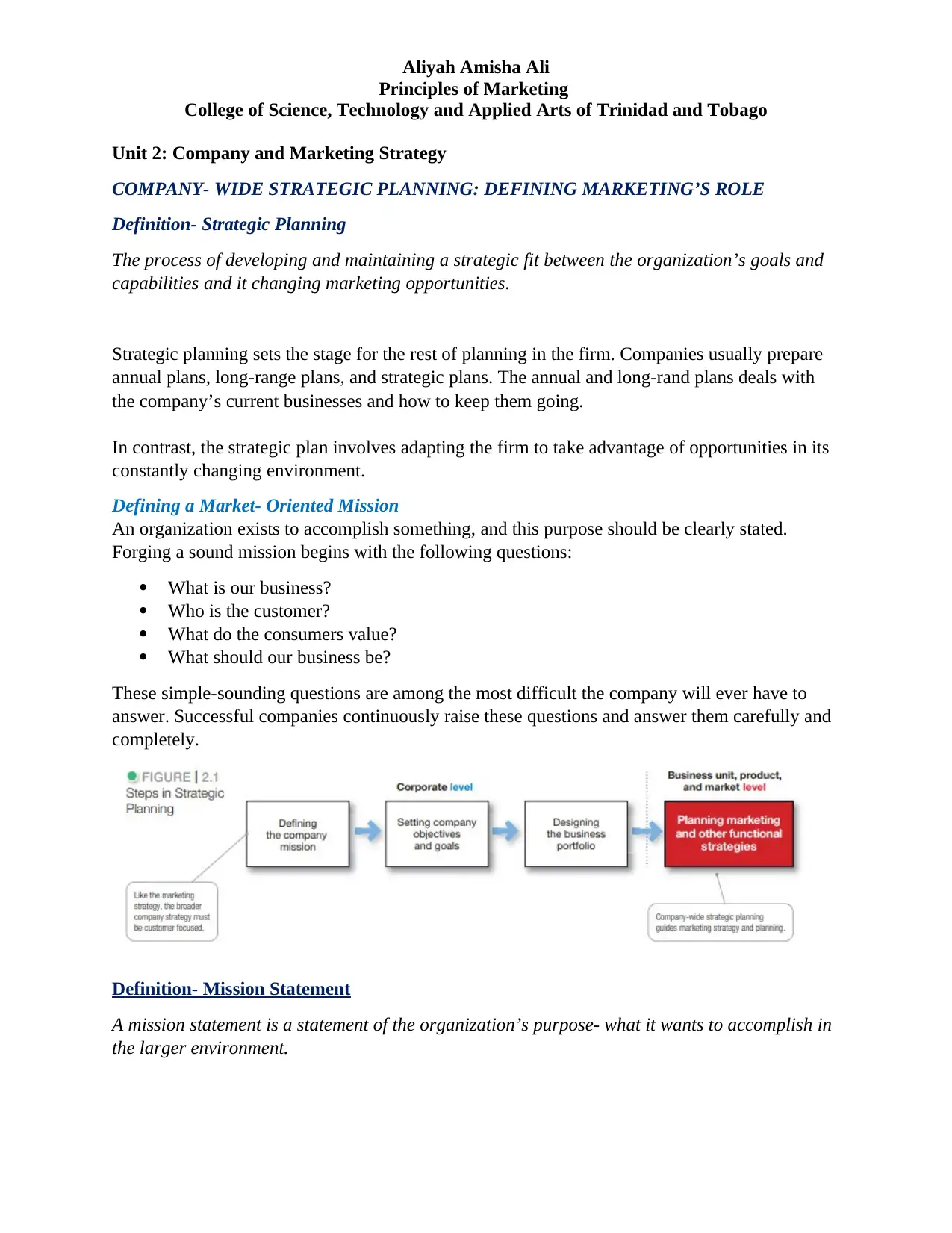
Aliyah Amisha Ali
Principles of Marketing
College of Science, Technology and Applied Arts of Trinidad and Tobago
Unit 2: Company and Marketing Strategy
COMPANY- WIDE STRATEGIC PLANNING: DEFINING MARKETING’S ROLE
Definition- Strategic Planning
The process of developing and maintaining a strategic fit between the organization’s goals and
capabilities and it changing marketing opportunities.
Strategic planning sets the stage for the rest of planning in the firm. Companies usually prepare
annual plans, long-range plans, and strategic plans. The annual and long-rand plans deals with
the company’s current businesses and how to keep them going.
In contrast, the strategic plan involves adapting the firm to take advantage of opportunities in its
constantly changing environment.
Defining a Market- Oriented Mission
An organization exists to accomplish something, and this purpose should be clearly stated.
Forging a sound mission begins with the following questions:
What is our business?
Who is the customer?
What do the consumers value?
What should our business be?
These simple-sounding questions are among the most difficult the company will ever have to
answer. Successful companies continuously raise these questions and answer them carefully and
completely.
Definition- Mission Statement
A mission statement is a statement of the organization’s purpose- what it wants to accomplish in
the larger environment.
Principles of Marketing
College of Science, Technology and Applied Arts of Trinidad and Tobago
Unit 2: Company and Marketing Strategy
COMPANY- WIDE STRATEGIC PLANNING: DEFINING MARKETING’S ROLE
Definition- Strategic Planning
The process of developing and maintaining a strategic fit between the organization’s goals and
capabilities and it changing marketing opportunities.
Strategic planning sets the stage for the rest of planning in the firm. Companies usually prepare
annual plans, long-range plans, and strategic plans. The annual and long-rand plans deals with
the company’s current businesses and how to keep them going.
In contrast, the strategic plan involves adapting the firm to take advantage of opportunities in its
constantly changing environment.
Defining a Market- Oriented Mission
An organization exists to accomplish something, and this purpose should be clearly stated.
Forging a sound mission begins with the following questions:
What is our business?
Who is the customer?
What do the consumers value?
What should our business be?
These simple-sounding questions are among the most difficult the company will ever have to
answer. Successful companies continuously raise these questions and answer them carefully and
completely.
Definition- Mission Statement
A mission statement is a statement of the organization’s purpose- what it wants to accomplish in
the larger environment.
Paraphrase This Document
Need a fresh take? Get an instant paraphrase of this document with our AI Paraphraser
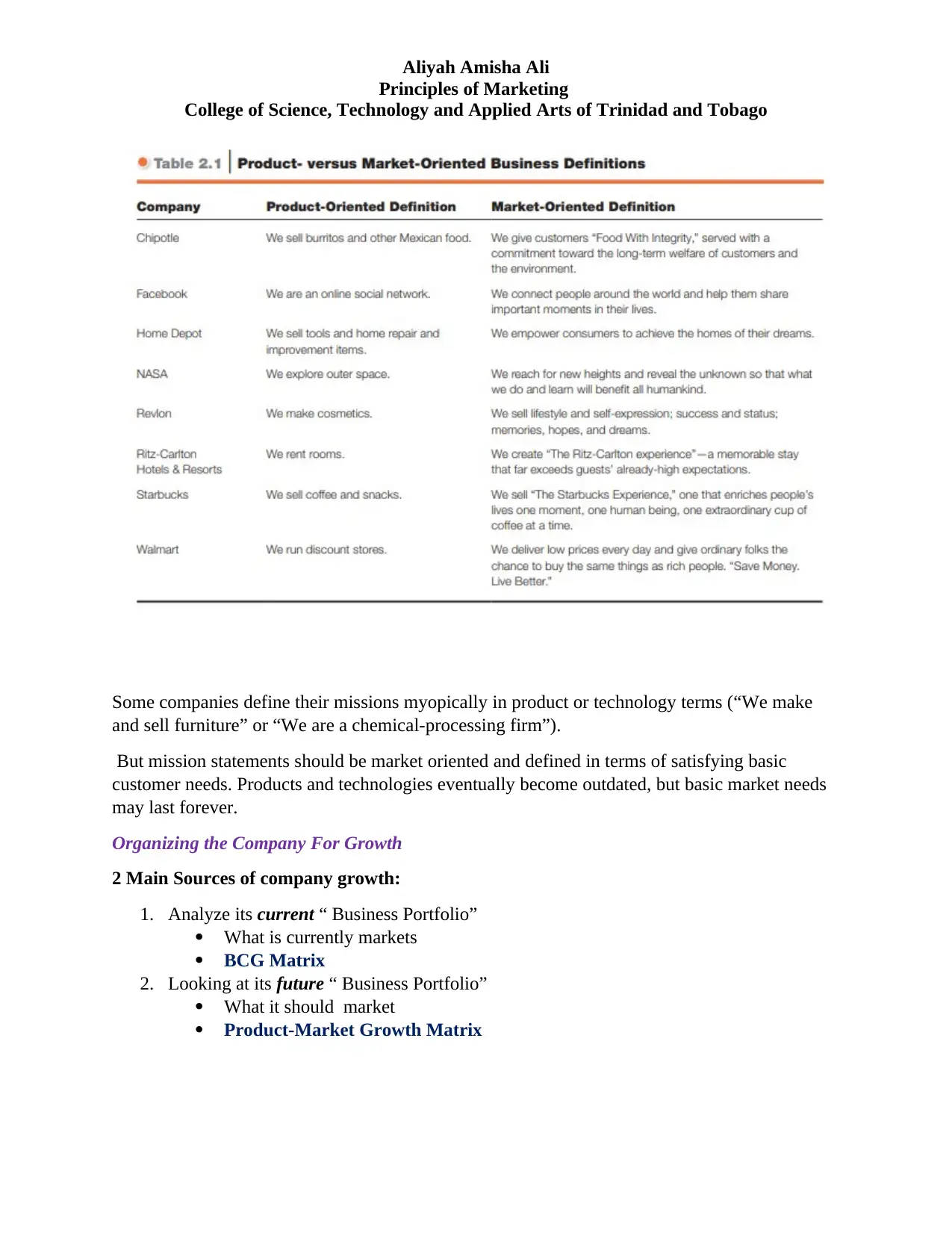
Aliyah Amisha Ali
Principles of Marketing
College of Science, Technology and Applied Arts of Trinidad and Tobago
Some companies define their missions myopically in product or technology terms (“We make
and sell furniture” or “We are a chemical-processing firm”).
But mission statements should be market oriented and defined in terms of satisfying basic
customer needs. Products and technologies eventually become outdated, but basic market needs
may last forever.
Organizing the Company For Growth
2 Main Sources of company growth:
1. Analyze its current “ Business Portfolio”
What is currently markets
BCG Matrix
2. Looking at its future “ Business Portfolio”
What it should market
Product-Market Growth Matrix
Principles of Marketing
College of Science, Technology and Applied Arts of Trinidad and Tobago
Some companies define their missions myopically in product or technology terms (“We make
and sell furniture” or “We are a chemical-processing firm”).
But mission statements should be market oriented and defined in terms of satisfying basic
customer needs. Products and technologies eventually become outdated, but basic market needs
may last forever.
Organizing the Company For Growth
2 Main Sources of company growth:
1. Analyze its current “ Business Portfolio”
What is currently markets
BCG Matrix
2. Looking at its future “ Business Portfolio”
What it should market
Product-Market Growth Matrix
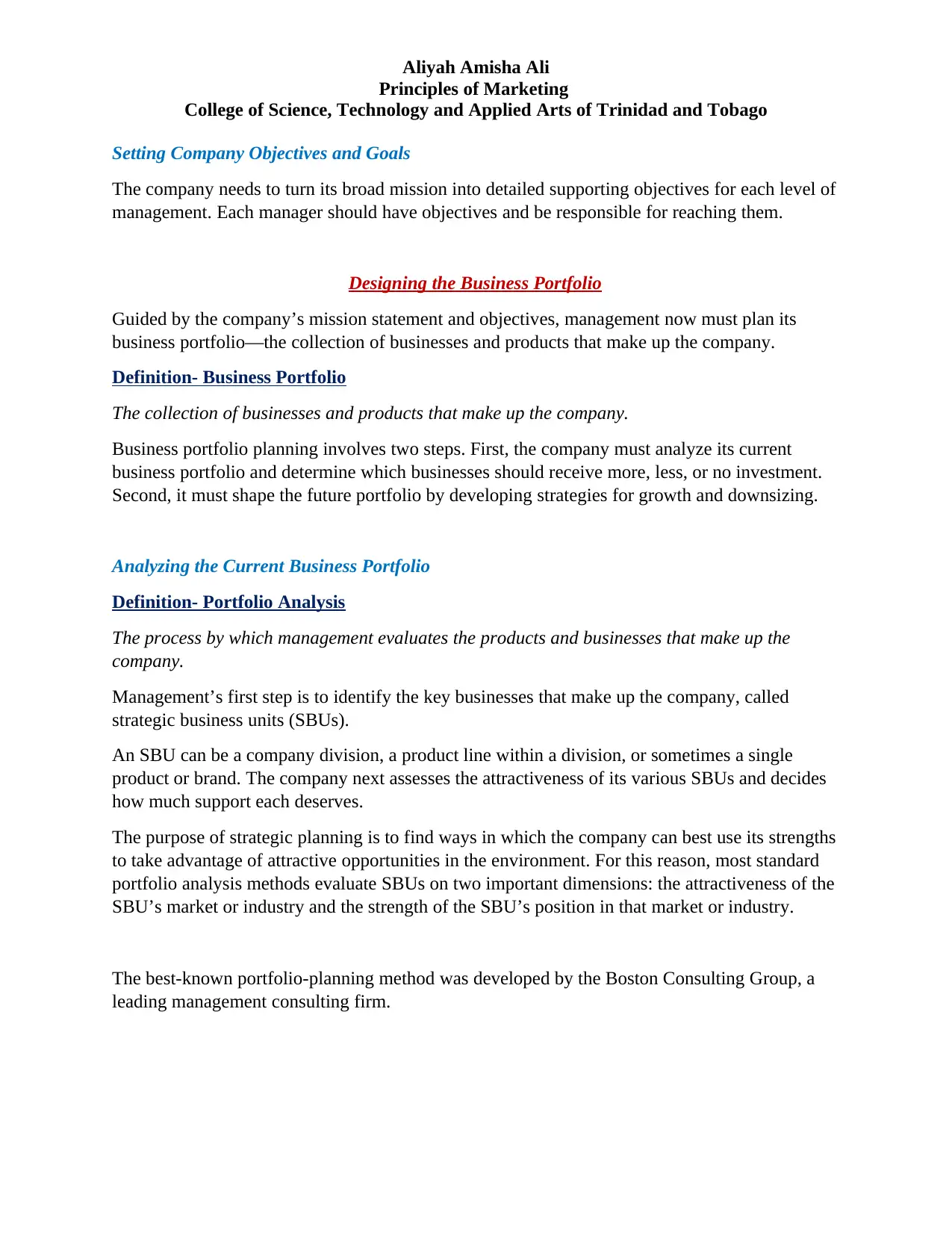
Aliyah Amisha Ali
Principles of Marketing
College of Science, Technology and Applied Arts of Trinidad and Tobago
Setting Company Objectives and Goals
The company needs to turn its broad mission into detailed supporting objectives for each level of
management. Each manager should have objectives and be responsible for reaching them.
Designing the Business Portfolio
Guided by the company’s mission statement and objectives, management now must plan its
business portfolio—the collection of businesses and products that make up the company.
Definition- Business Portfolio
The collection of businesses and products that make up the company.
Business portfolio planning involves two steps. First, the company must analyze its current
business portfolio and determine which businesses should receive more, less, or no investment.
Second, it must shape the future portfolio by developing strategies for growth and downsizing.
Analyzing the Current Business Portfolio
Definition- Portfolio Analysis
The process by which management evaluates the products and businesses that make up the
company.
Management’s first step is to identify the key businesses that make up the company, called
strategic business units (SBUs).
An SBU can be a company division, a product line within a division, or sometimes a single
product or brand. The company next assesses the attractiveness of its various SBUs and decides
how much support each deserves.
The purpose of strategic planning is to find ways in which the company can best use its strengths
to take advantage of attractive opportunities in the environment. For this reason, most standard
portfolio analysis methods evaluate SBUs on two important dimensions: the attractiveness of the
SBU’s market or industry and the strength of the SBU’s position in that market or industry.
The best-known portfolio-planning method was developed by the Boston Consulting Group, a
leading management consulting firm.
Principles of Marketing
College of Science, Technology and Applied Arts of Trinidad and Tobago
Setting Company Objectives and Goals
The company needs to turn its broad mission into detailed supporting objectives for each level of
management. Each manager should have objectives and be responsible for reaching them.
Designing the Business Portfolio
Guided by the company’s mission statement and objectives, management now must plan its
business portfolio—the collection of businesses and products that make up the company.
Definition- Business Portfolio
The collection of businesses and products that make up the company.
Business portfolio planning involves two steps. First, the company must analyze its current
business portfolio and determine which businesses should receive more, less, or no investment.
Second, it must shape the future portfolio by developing strategies for growth and downsizing.
Analyzing the Current Business Portfolio
Definition- Portfolio Analysis
The process by which management evaluates the products and businesses that make up the
company.
Management’s first step is to identify the key businesses that make up the company, called
strategic business units (SBUs).
An SBU can be a company division, a product line within a division, or sometimes a single
product or brand. The company next assesses the attractiveness of its various SBUs and decides
how much support each deserves.
The purpose of strategic planning is to find ways in which the company can best use its strengths
to take advantage of attractive opportunities in the environment. For this reason, most standard
portfolio analysis methods evaluate SBUs on two important dimensions: the attractiveness of the
SBU’s market or industry and the strength of the SBU’s position in that market or industry.
The best-known portfolio-planning method was developed by the Boston Consulting Group, a
leading management consulting firm.
⊘ This is a preview!⊘
Do you want full access?
Subscribe today to unlock all pages.

Trusted by 1+ million students worldwide
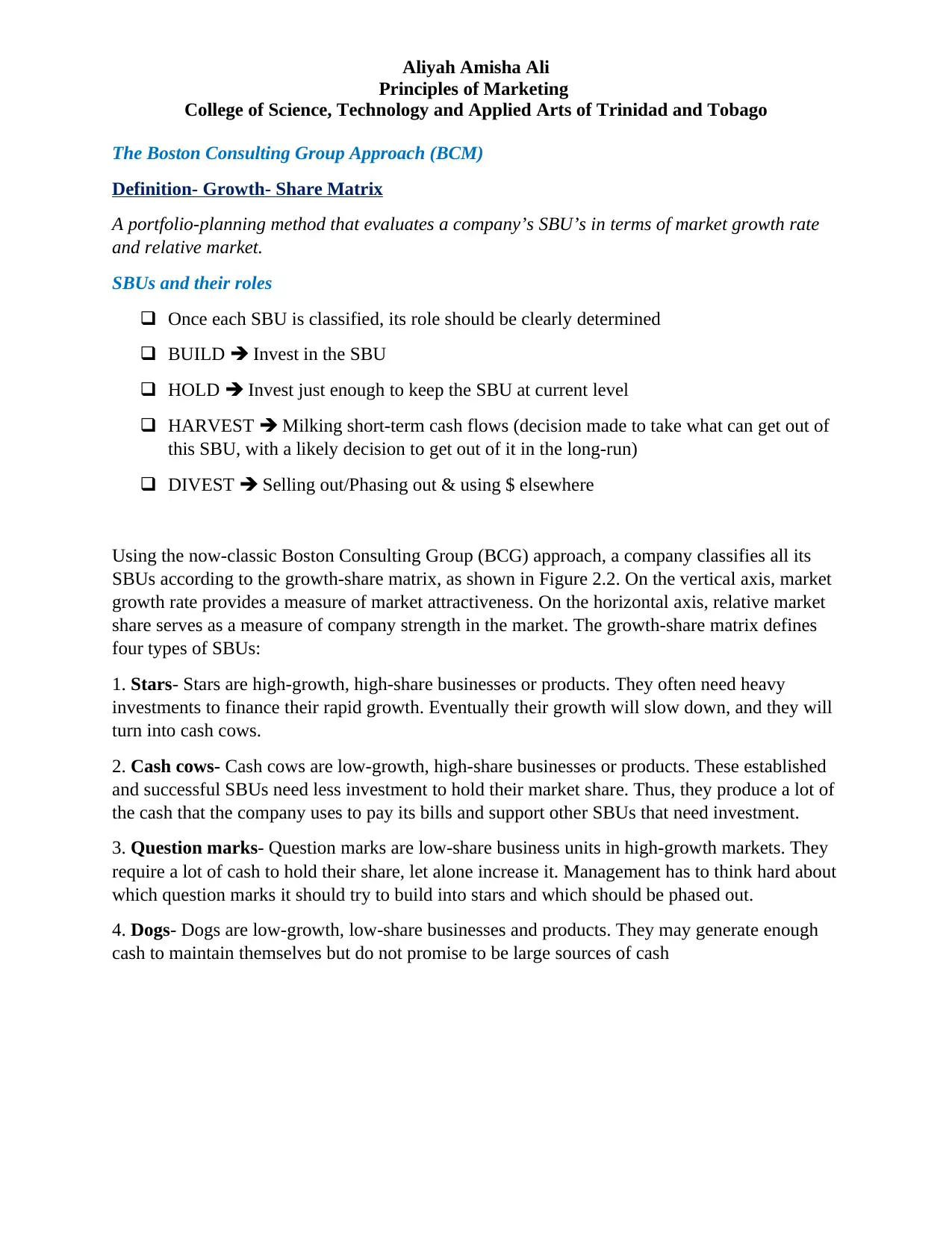
Aliyah Amisha Ali
Principles of Marketing
College of Science, Technology and Applied Arts of Trinidad and Tobago
The Boston Consulting Group Approach (BCM)
Definition- Growth- Share Matrix
A portfolio-planning method that evaluates a company’s SBU’s in terms of market growth rate
and relative market.
SBUs and their roles
Once each SBU is classified, its role should be clearly determined
BUILD Invest in the SBU
HOLD Invest just enough to keep the SBU at current level
HARVEST Milking short-term cash flows (decision made to take what can get out of
this SBU, with a likely decision to get out of it in the long-run)
DIVEST Selling out/Phasing out & using $ elsewhere
Using the now-classic Boston Consulting Group (BCG) approach, a company classifies all its
SBUs according to the growth-share matrix, as shown in Figure 2.2. On the vertical axis, market
growth rate provides a measure of market attractiveness. On the horizontal axis, relative market
share serves as a measure of company strength in the market. The growth-share matrix defines
four types of SBUs:
1. Stars- Stars are high-growth, high-share businesses or products. They often need heavy
investments to finance their rapid growth. Eventually their growth will slow down, and they will
turn into cash cows.
2. Cash cows- Cash cows are low-growth, high-share businesses or products. These established
and successful SBUs need less investment to hold their market share. Thus, they produce a lot of
the cash that the company uses to pay its bills and support other SBUs that need investment.
3. Question marks- Question marks are low-share business units in high-growth markets. They
require a lot of cash to hold their share, let alone increase it. Management has to think hard about
which question marks it should try to build into stars and which should be phased out.
4. Dogs- Dogs are low-growth, low-share businesses and products. They may generate enough
cash to maintain themselves but do not promise to be large sources of cash
Principles of Marketing
College of Science, Technology and Applied Arts of Trinidad and Tobago
The Boston Consulting Group Approach (BCM)
Definition- Growth- Share Matrix
A portfolio-planning method that evaluates a company’s SBU’s in terms of market growth rate
and relative market.
SBUs and their roles
Once each SBU is classified, its role should be clearly determined
BUILD Invest in the SBU
HOLD Invest just enough to keep the SBU at current level
HARVEST Milking short-term cash flows (decision made to take what can get out of
this SBU, with a likely decision to get out of it in the long-run)
DIVEST Selling out/Phasing out & using $ elsewhere
Using the now-classic Boston Consulting Group (BCG) approach, a company classifies all its
SBUs according to the growth-share matrix, as shown in Figure 2.2. On the vertical axis, market
growth rate provides a measure of market attractiveness. On the horizontal axis, relative market
share serves as a measure of company strength in the market. The growth-share matrix defines
four types of SBUs:
1. Stars- Stars are high-growth, high-share businesses or products. They often need heavy
investments to finance their rapid growth. Eventually their growth will slow down, and they will
turn into cash cows.
2. Cash cows- Cash cows are low-growth, high-share businesses or products. These established
and successful SBUs need less investment to hold their market share. Thus, they produce a lot of
the cash that the company uses to pay its bills and support other SBUs that need investment.
3. Question marks- Question marks are low-share business units in high-growth markets. They
require a lot of cash to hold their share, let alone increase it. Management has to think hard about
which question marks it should try to build into stars and which should be phased out.
4. Dogs- Dogs are low-growth, low-share businesses and products. They may generate enough
cash to maintain themselves but do not promise to be large sources of cash
Paraphrase This Document
Need a fresh take? Get an instant paraphrase of this document with our AI Paraphraser
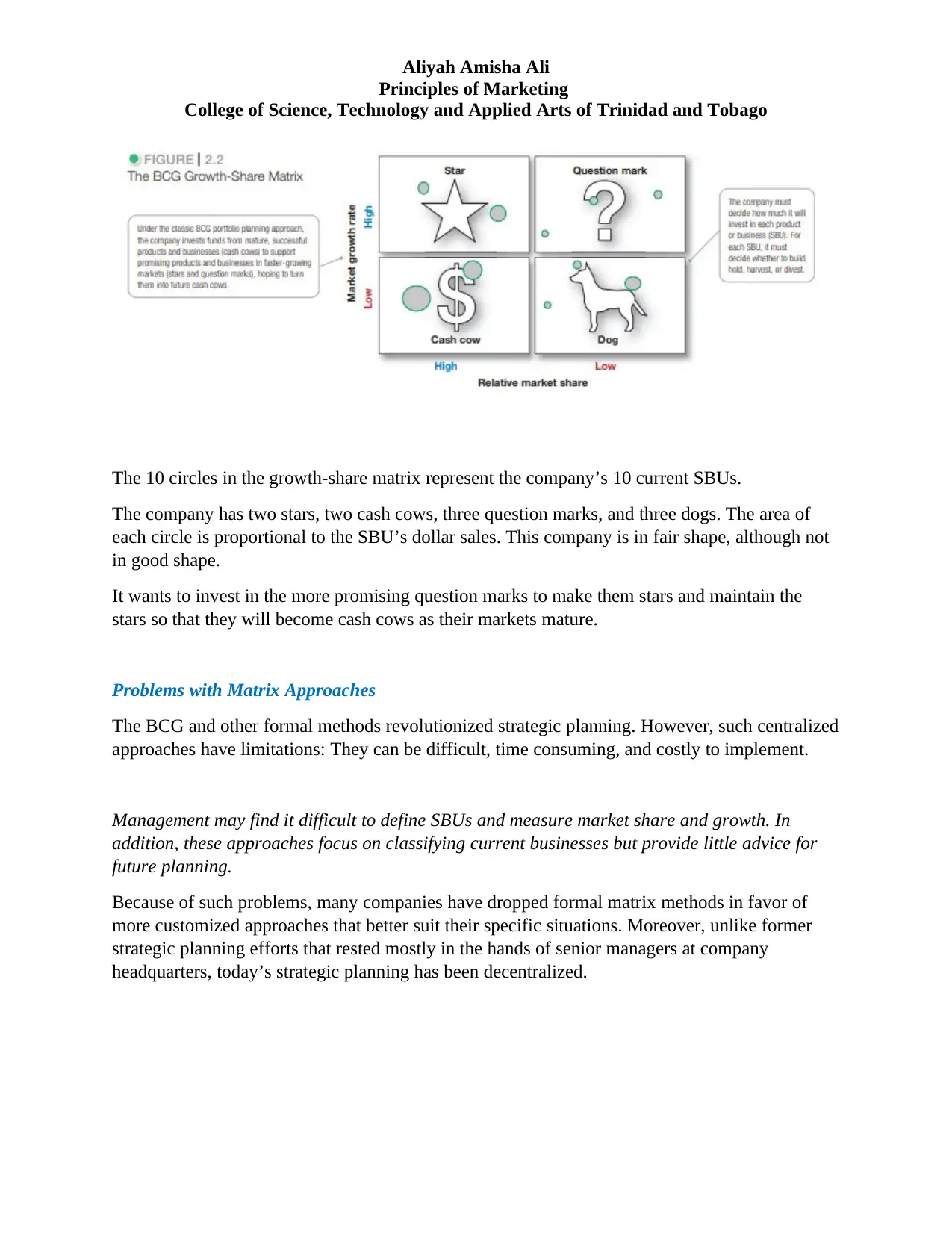
Aliyah Amisha Ali
Principles of Marketing
College of Science, Technology and Applied Arts of Trinidad and Tobago
The 10 circles in the growth-share matrix represent the company’s 10 current SBUs.
The company has two stars, two cash cows, three question marks, and three dogs. The area of
each circle is proportional to the SBU’s dollar sales. This company is in fair shape, although not
in good shape.
It wants to invest in the more promising question marks to make them stars and maintain the
stars so that they will become cash cows as their markets mature.
Problems with Matrix Approaches
The BCG and other formal methods revolutionized strategic planning. However, such centralized
approaches have limitations: They can be difficult, time consuming, and costly to implement.
Management may find it difficult to define SBUs and measure market share and growth. In
addition, these approaches focus on classifying current businesses but provide little advice for
future planning.
Because of such problems, many companies have dropped formal matrix methods in favor of
more customized approaches that better suit their specific situations. Moreover, unlike former
strategic planning efforts that rested mostly in the hands of senior managers at company
headquarters, today’s strategic planning has been decentralized.
Principles of Marketing
College of Science, Technology and Applied Arts of Trinidad and Tobago
The 10 circles in the growth-share matrix represent the company’s 10 current SBUs.
The company has two stars, two cash cows, three question marks, and three dogs. The area of
each circle is proportional to the SBU’s dollar sales. This company is in fair shape, although not
in good shape.
It wants to invest in the more promising question marks to make them stars and maintain the
stars so that they will become cash cows as their markets mature.
Problems with Matrix Approaches
The BCG and other formal methods revolutionized strategic planning. However, such centralized
approaches have limitations: They can be difficult, time consuming, and costly to implement.
Management may find it difficult to define SBUs and measure market share and growth. In
addition, these approaches focus on classifying current businesses but provide little advice for
future planning.
Because of such problems, many companies have dropped formal matrix methods in favor of
more customized approaches that better suit their specific situations. Moreover, unlike former
strategic planning efforts that rested mostly in the hands of senior managers at company
headquarters, today’s strategic planning has been decentralized.
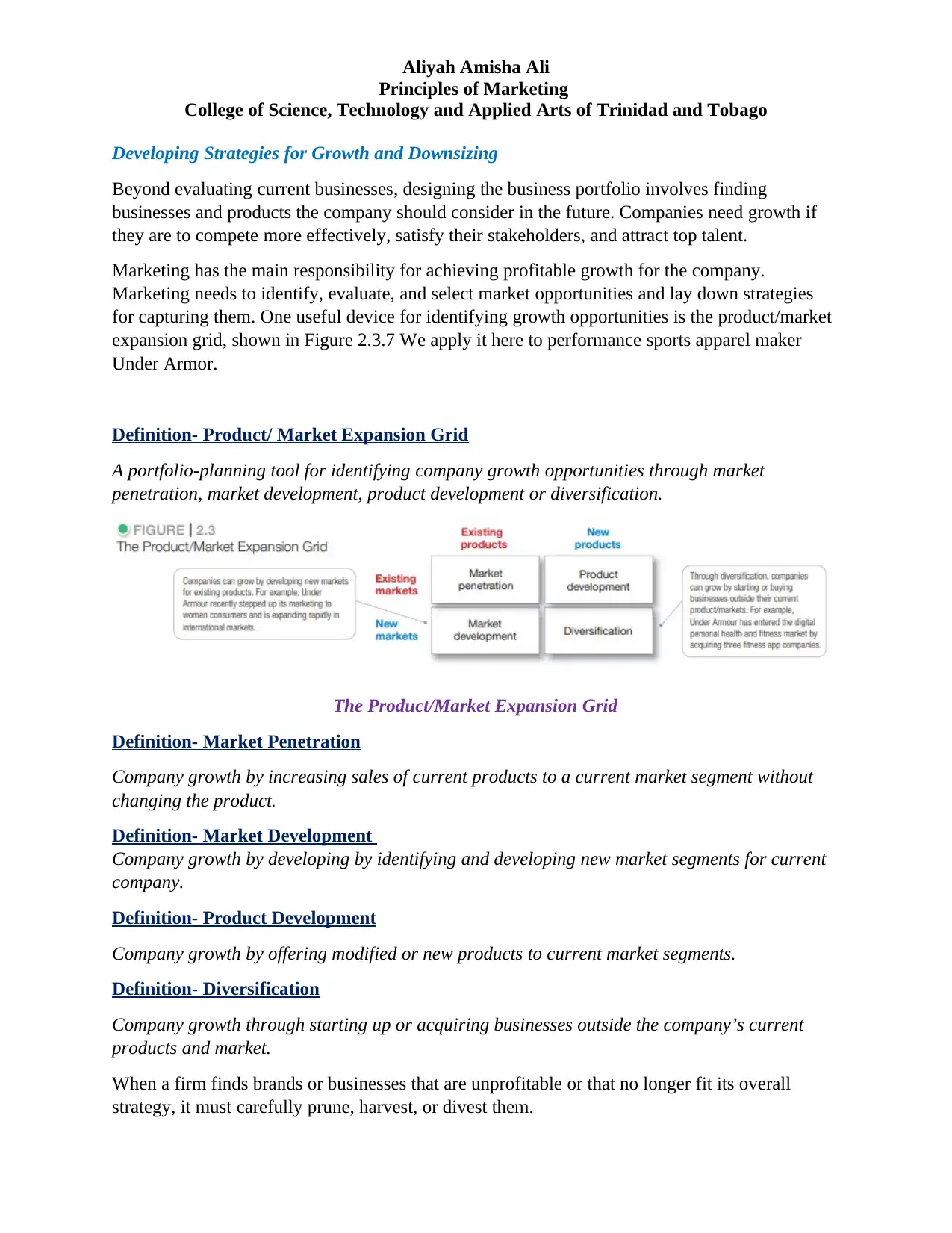
Aliyah Amisha Ali
Principles of Marketing
College of Science, Technology and Applied Arts of Trinidad and Tobago
Developing Strategies for Growth and Downsizing
Beyond evaluating current businesses, designing the business portfolio involves finding
businesses and products the company should consider in the future. Companies need growth if
they are to compete more effectively, satisfy their stakeholders, and attract top talent.
Marketing has the main responsibility for achieving profitable growth for the company.
Marketing needs to identify, evaluate, and select market opportunities and lay down strategies
for capturing them. One useful device for identifying growth opportunities is the product/market
expansion grid, shown in Figure 2.3.7 We apply it here to performance sports apparel maker
Under Armor.
Definition- Product/ Market Expansion Grid
A portfolio-planning tool for identifying company growth opportunities through market
penetration, market development, product development or diversification.
The Product/Market Expansion Grid
Definition- Market Penetration
Company growth by increasing sales of current products to a current market segment without
changing the product.
Definition- Market Development
Company growth by developing by identifying and developing new market segments for current
company.
Definition- Product Development
Company growth by offering modified or new products to current market segments.
Definition- Diversification
Company growth through starting up or acquiring businesses outside the company’s current
products and market.
When a firm finds brands or businesses that are unprofitable or that no longer fit its overall
strategy, it must carefully prune, harvest, or divest them.
Principles of Marketing
College of Science, Technology and Applied Arts of Trinidad and Tobago
Developing Strategies for Growth and Downsizing
Beyond evaluating current businesses, designing the business portfolio involves finding
businesses and products the company should consider in the future. Companies need growth if
they are to compete more effectively, satisfy their stakeholders, and attract top talent.
Marketing has the main responsibility for achieving profitable growth for the company.
Marketing needs to identify, evaluate, and select market opportunities and lay down strategies
for capturing them. One useful device for identifying growth opportunities is the product/market
expansion grid, shown in Figure 2.3.7 We apply it here to performance sports apparel maker
Under Armor.
Definition- Product/ Market Expansion Grid
A portfolio-planning tool for identifying company growth opportunities through market
penetration, market development, product development or diversification.
The Product/Market Expansion Grid
Definition- Market Penetration
Company growth by increasing sales of current products to a current market segment without
changing the product.
Definition- Market Development
Company growth by developing by identifying and developing new market segments for current
company.
Definition- Product Development
Company growth by offering modified or new products to current market segments.
Definition- Diversification
Company growth through starting up or acquiring businesses outside the company’s current
products and market.
When a firm finds brands or businesses that are unprofitable or that no longer fit its overall
strategy, it must carefully prune, harvest, or divest them.
⊘ This is a preview!⊘
Do you want full access?
Subscribe today to unlock all pages.

Trusted by 1+ million students worldwide
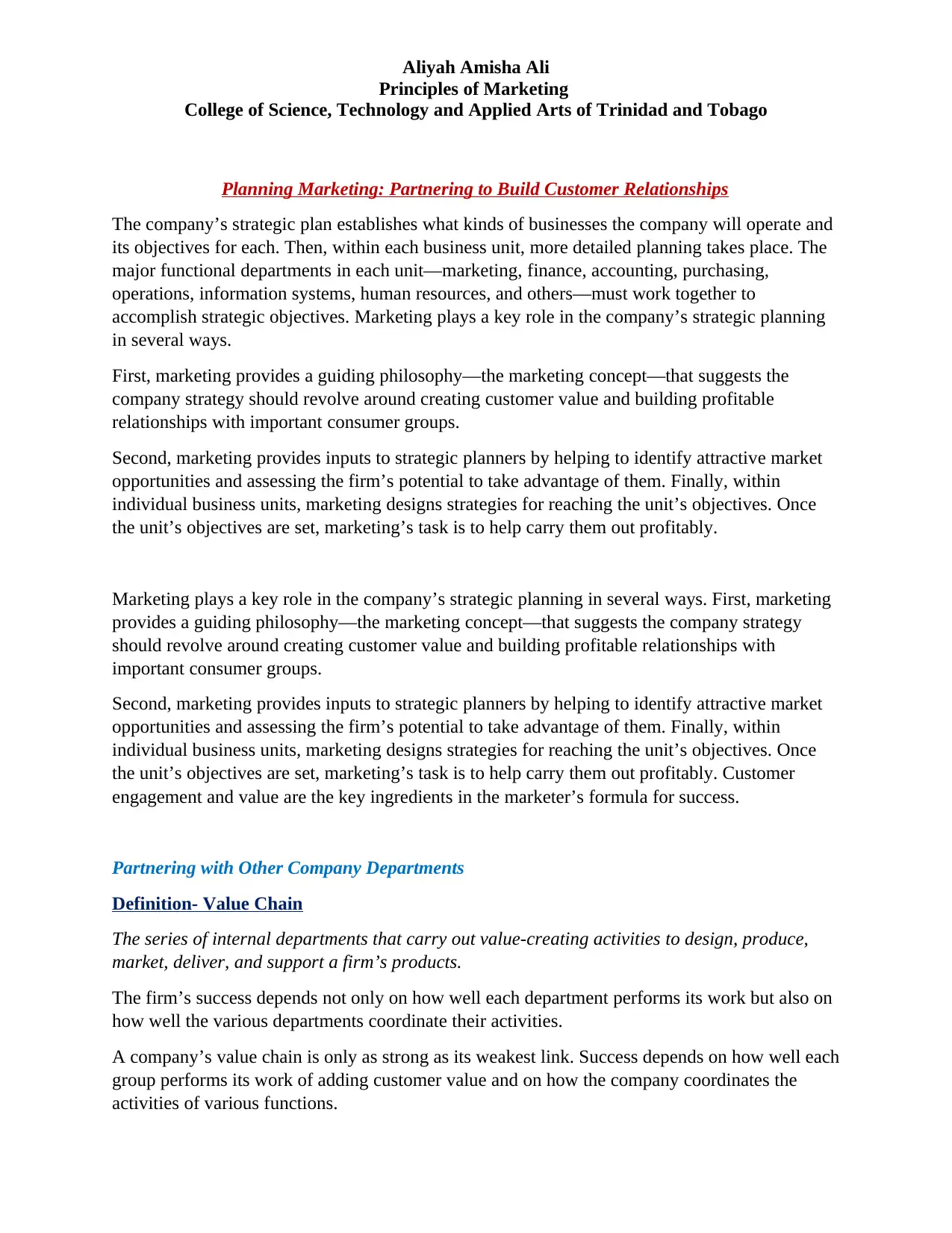
Aliyah Amisha Ali
Principles of Marketing
College of Science, Technology and Applied Arts of Trinidad and Tobago
Planning Marketing: Partnering to Build Customer Relationships
The company’s strategic plan establishes what kinds of businesses the company will operate and
its objectives for each. Then, within each business unit, more detailed planning takes place. The
major functional departments in each unit—marketing, finance, accounting, purchasing,
operations, information systems, human resources, and others—must work together to
accomplish strategic objectives. Marketing plays a key role in the company’s strategic planning
in several ways.
First, marketing provides a guiding philosophy—the marketing concept—that suggests the
company strategy should revolve around creating customer value and building profitable
relationships with important consumer groups.
Second, marketing provides inputs to strategic planners by helping to identify attractive market
opportunities and assessing the firm’s potential to take advantage of them. Finally, within
individual business units, marketing designs strategies for reaching the unit’s objectives. Once
the unit’s objectives are set, marketing’s task is to help carry them out profitably.
Marketing plays a key role in the company’s strategic planning in several ways. First, marketing
provides a guiding philosophy—the marketing concept—that suggests the company strategy
should revolve around creating customer value and building profitable relationships with
important consumer groups.
Second, marketing provides inputs to strategic planners by helping to identify attractive market
opportunities and assessing the firm’s potential to take advantage of them. Finally, within
individual business units, marketing designs strategies for reaching the unit’s objectives. Once
the unit’s objectives are set, marketing’s task is to help carry them out profitably. Customer
engagement and value are the key ingredients in the marketer’s formula for success.
Partnering with Other Company Departments
Definition- Value Chain
The series of internal departments that carry out value-creating activities to design, produce,
market, deliver, and support a firm’s products.
The firm’s success depends not only on how well each department performs its work but also on
how well the various departments coordinate their activities.
A company’s value chain is only as strong as its weakest link. Success depends on how well each
group performs its work of adding customer value and on how the company coordinates the
activities of various functions.
Principles of Marketing
College of Science, Technology and Applied Arts of Trinidad and Tobago
Planning Marketing: Partnering to Build Customer Relationships
The company’s strategic plan establishes what kinds of businesses the company will operate and
its objectives for each. Then, within each business unit, more detailed planning takes place. The
major functional departments in each unit—marketing, finance, accounting, purchasing,
operations, information systems, human resources, and others—must work together to
accomplish strategic objectives. Marketing plays a key role in the company’s strategic planning
in several ways.
First, marketing provides a guiding philosophy—the marketing concept—that suggests the
company strategy should revolve around creating customer value and building profitable
relationships with important consumer groups.
Second, marketing provides inputs to strategic planners by helping to identify attractive market
opportunities and assessing the firm’s potential to take advantage of them. Finally, within
individual business units, marketing designs strategies for reaching the unit’s objectives. Once
the unit’s objectives are set, marketing’s task is to help carry them out profitably.
Marketing plays a key role in the company’s strategic planning in several ways. First, marketing
provides a guiding philosophy—the marketing concept—that suggests the company strategy
should revolve around creating customer value and building profitable relationships with
important consumer groups.
Second, marketing provides inputs to strategic planners by helping to identify attractive market
opportunities and assessing the firm’s potential to take advantage of them. Finally, within
individual business units, marketing designs strategies for reaching the unit’s objectives. Once
the unit’s objectives are set, marketing’s task is to help carry them out profitably. Customer
engagement and value are the key ingredients in the marketer’s formula for success.
Partnering with Other Company Departments
Definition- Value Chain
The series of internal departments that carry out value-creating activities to design, produce,
market, deliver, and support a firm’s products.
The firm’s success depends not only on how well each department performs its work but also on
how well the various departments coordinate their activities.
A company’s value chain is only as strong as its weakest link. Success depends on how well each
group performs its work of adding customer value and on how the company coordinates the
activities of various functions.
Paraphrase This Document
Need a fresh take? Get an instant paraphrase of this document with our AI Paraphraser
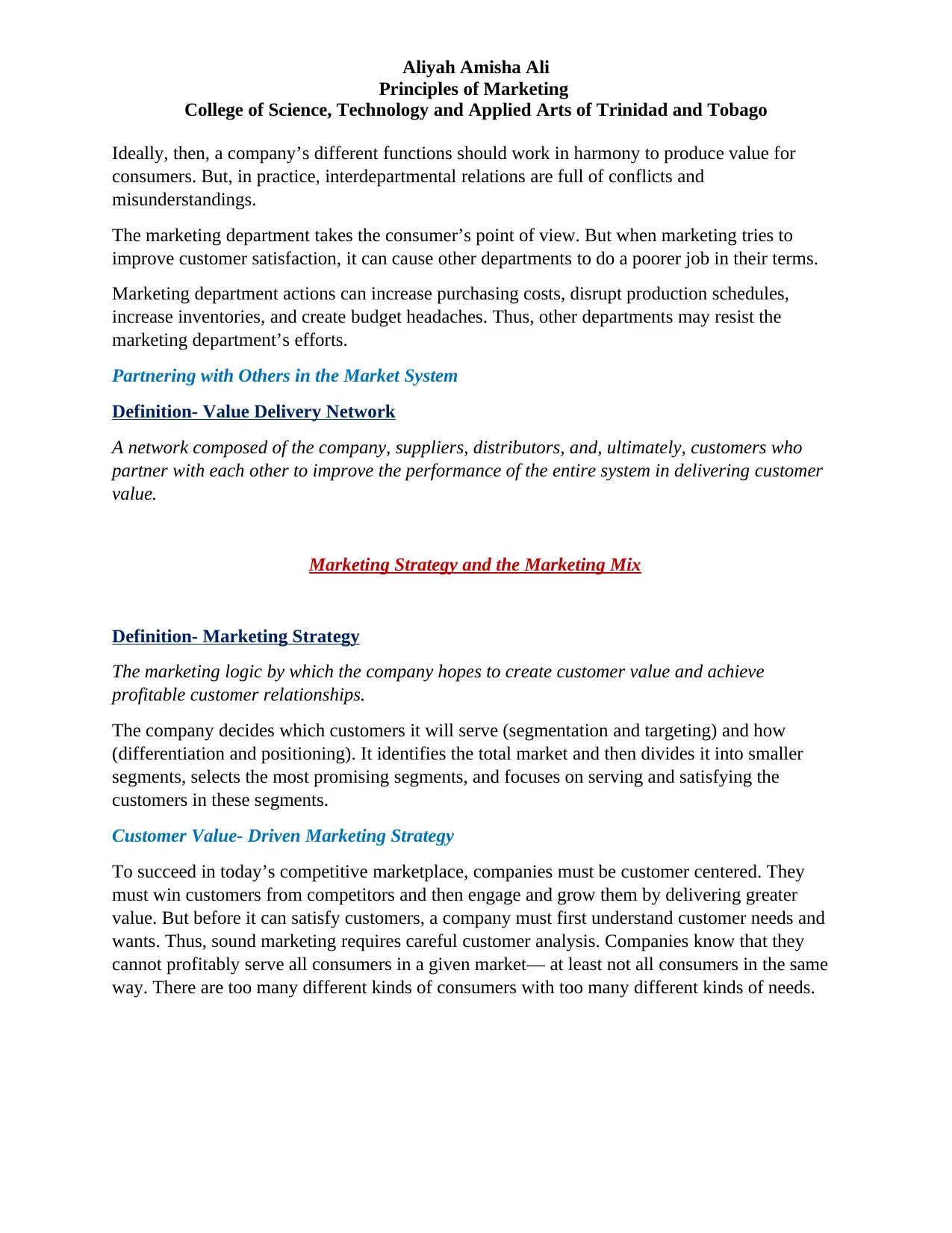
Aliyah Amisha Ali
Principles of Marketing
College of Science, Technology and Applied Arts of Trinidad and Tobago
Ideally, then, a company’s different functions should work in harmony to produce value for
consumers. But, in practice, interdepartmental relations are full of conflicts and
misunderstandings.
The marketing department takes the consumer’s point of view. But when marketing tries to
improve customer satisfaction, it can cause other departments to do a poorer job in their terms.
Marketing department actions can increase purchasing costs, disrupt production schedules,
increase inventories, and create budget headaches. Thus, other departments may resist the
marketing department’s efforts.
Partnering with Others in the Market System
Definition- Value Delivery Network
A network composed of the company, suppliers, distributors, and, ultimately, customers who
partner with each other to improve the performance of the entire system in delivering customer
value.
Marketing Strategy and the Marketing Mix
Definition- Marketing Strategy
The marketing logic by which the company hopes to create customer value and achieve
profitable customer relationships.
The company decides which customers it will serve (segmentation and targeting) and how
(differentiation and positioning). It identifies the total market and then divides it into smaller
segments, selects the most promising segments, and focuses on serving and satisfying the
customers in these segments.
Customer Value- Driven Marketing Strategy
To succeed in today’s competitive marketplace, companies must be customer centered. They
must win customers from competitors and then engage and grow them by delivering greater
value. But before it can satisfy customers, a company must first understand customer needs and
wants. Thus, sound marketing requires careful customer analysis. Companies know that they
cannot profitably serve all consumers in a given market— at least not all consumers in the same
way. There are too many different kinds of consumers with too many different kinds of needs.
Principles of Marketing
College of Science, Technology and Applied Arts of Trinidad and Tobago
Ideally, then, a company’s different functions should work in harmony to produce value for
consumers. But, in practice, interdepartmental relations are full of conflicts and
misunderstandings.
The marketing department takes the consumer’s point of view. But when marketing tries to
improve customer satisfaction, it can cause other departments to do a poorer job in their terms.
Marketing department actions can increase purchasing costs, disrupt production schedules,
increase inventories, and create budget headaches. Thus, other departments may resist the
marketing department’s efforts.
Partnering with Others in the Market System
Definition- Value Delivery Network
A network composed of the company, suppliers, distributors, and, ultimately, customers who
partner with each other to improve the performance of the entire system in delivering customer
value.
Marketing Strategy and the Marketing Mix
Definition- Marketing Strategy
The marketing logic by which the company hopes to create customer value and achieve
profitable customer relationships.
The company decides which customers it will serve (segmentation and targeting) and how
(differentiation and positioning). It identifies the total market and then divides it into smaller
segments, selects the most promising segments, and focuses on serving and satisfying the
customers in these segments.
Customer Value- Driven Marketing Strategy
To succeed in today’s competitive marketplace, companies must be customer centered. They
must win customers from competitors and then engage and grow them by delivering greater
value. But before it can satisfy customers, a company must first understand customer needs and
wants. Thus, sound marketing requires careful customer analysis. Companies know that they
cannot profitably serve all consumers in a given market— at least not all consumers in the same
way. There are too many different kinds of consumers with too many different kinds of needs.
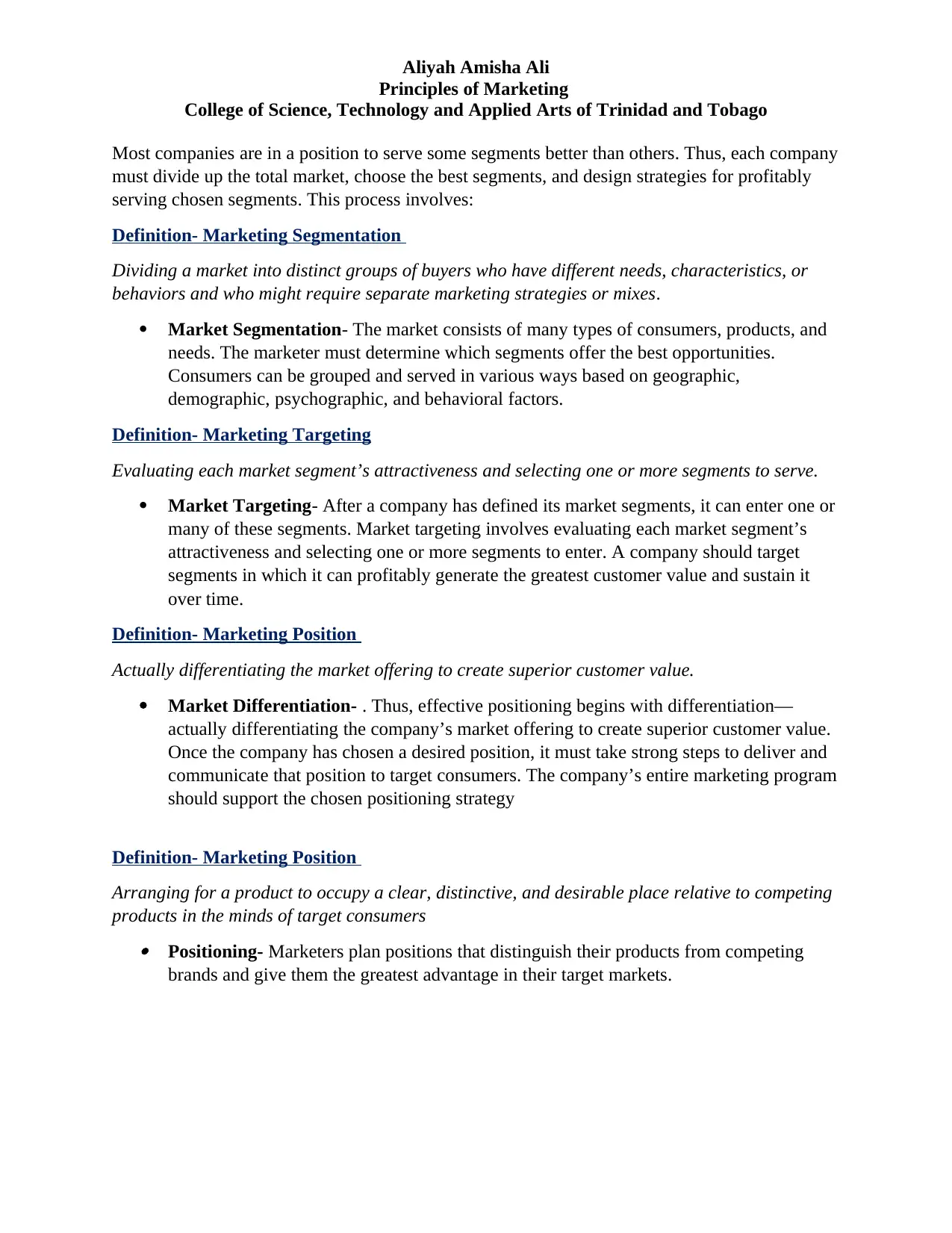
Aliyah Amisha Ali
Principles of Marketing
College of Science, Technology and Applied Arts of Trinidad and Tobago
Most companies are in a position to serve some segments better than others. Thus, each company
must divide up the total market, choose the best segments, and design strategies for profitably
serving chosen segments. This process involves:
Definition- Marketing Segmentation
Dividing a market into distinct groups of buyers who have different needs, characteristics, or
behaviors and who might require separate marketing strategies or mixes.
Market Segmentation- The market consists of many types of consumers, products, and
needs. The marketer must determine which segments offer the best opportunities.
Consumers can be grouped and served in various ways based on geographic,
demographic, psychographic, and behavioral factors.
Definition- Marketing Targeting
Evaluating each market segment’s attractiveness and selecting one or more segments to serve.
Market Targeting- After a company has defined its market segments, it can enter one or
many of these segments. Market targeting involves evaluating each market segment’s
attractiveness and selecting one or more segments to enter. A company should target
segments in which it can profitably generate the greatest customer value and sustain it
over time.
Definition- Marketing Position
Actually differentiating the market offering to create superior customer value.
Market Differentiation- . Thus, effective positioning begins with differentiation—
actually differentiating the company’s market offering to create superior customer value.
Once the company has chosen a desired position, it must take strong steps to deliver and
communicate that position to target consumers. The company’s entire marketing program
should support the chosen positioning strategy
Definition- Marketing Position
Arranging for a product to occupy a clear, distinctive, and desirable place relative to competing
products in the minds of target consumers Positioning- Marketers plan positions that distinguish their products from competing
brands and give them the greatest advantage in their target markets.
Principles of Marketing
College of Science, Technology and Applied Arts of Trinidad and Tobago
Most companies are in a position to serve some segments better than others. Thus, each company
must divide up the total market, choose the best segments, and design strategies for profitably
serving chosen segments. This process involves:
Definition- Marketing Segmentation
Dividing a market into distinct groups of buyers who have different needs, characteristics, or
behaviors and who might require separate marketing strategies or mixes.
Market Segmentation- The market consists of many types of consumers, products, and
needs. The marketer must determine which segments offer the best opportunities.
Consumers can be grouped and served in various ways based on geographic,
demographic, psychographic, and behavioral factors.
Definition- Marketing Targeting
Evaluating each market segment’s attractiveness and selecting one or more segments to serve.
Market Targeting- After a company has defined its market segments, it can enter one or
many of these segments. Market targeting involves evaluating each market segment’s
attractiveness and selecting one or more segments to enter. A company should target
segments in which it can profitably generate the greatest customer value and sustain it
over time.
Definition- Marketing Position
Actually differentiating the market offering to create superior customer value.
Market Differentiation- . Thus, effective positioning begins with differentiation—
actually differentiating the company’s market offering to create superior customer value.
Once the company has chosen a desired position, it must take strong steps to deliver and
communicate that position to target consumers. The company’s entire marketing program
should support the chosen positioning strategy
Definition- Marketing Position
Arranging for a product to occupy a clear, distinctive, and desirable place relative to competing
products in the minds of target consumers Positioning- Marketers plan positions that distinguish their products from competing
brands and give them the greatest advantage in their target markets.
⊘ This is a preview!⊘
Do you want full access?
Subscribe today to unlock all pages.

Trusted by 1+ million students worldwide
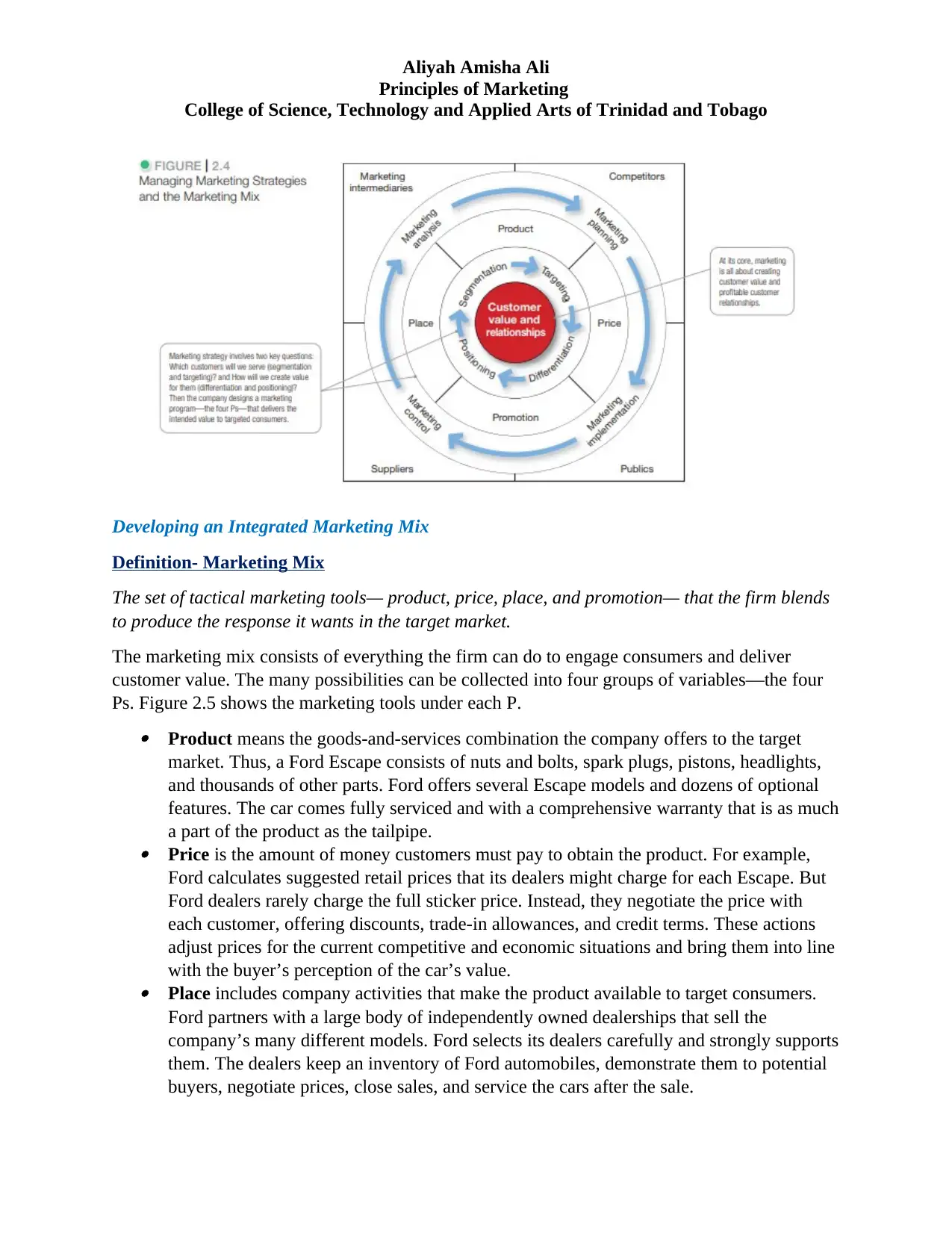
Aliyah Amisha Ali
Principles of Marketing
College of Science, Technology and Applied Arts of Trinidad and Tobago
Developing an Integrated Marketing Mix
Definition- Marketing Mix
The set of tactical marketing tools— product, price, place, and promotion— that the firm blends
to produce the response it wants in the target market.
The marketing mix consists of everything the firm can do to engage consumers and deliver
customer value. The many possibilities can be collected into four groups of variables—the four
Ps. Figure 2.5 shows the marketing tools under each P. Product means the goods-and-services combination the company offers to the target
market. Thus, a Ford Escape consists of nuts and bolts, spark plugs, pistons, headlights,
and thousands of other parts. Ford offers several Escape models and dozens of optional
features. The car comes fully serviced and with a comprehensive warranty that is as much
a part of the product as the tailpipe.
Price is the amount of money customers must pay to obtain the product. For example,
Ford calculates suggested retail prices that its dealers might charge for each Escape. But
Ford dealers rarely charge the full sticker price. Instead, they negotiate the price with
each customer, offering discounts, trade-in allowances, and credit terms. These actions
adjust prices for the current competitive and economic situations and bring them into line
with the buyer’s perception of the car’s value.
Place includes company activities that make the product available to target consumers.
Ford partners with a large body of independently owned dealerships that sell the
company’s many different models. Ford selects its dealers carefully and strongly supports
them. The dealers keep an inventory of Ford automobiles, demonstrate them to potential
buyers, negotiate prices, close sales, and service the cars after the sale.
Principles of Marketing
College of Science, Technology and Applied Arts of Trinidad and Tobago
Developing an Integrated Marketing Mix
Definition- Marketing Mix
The set of tactical marketing tools— product, price, place, and promotion— that the firm blends
to produce the response it wants in the target market.
The marketing mix consists of everything the firm can do to engage consumers and deliver
customer value. The many possibilities can be collected into four groups of variables—the four
Ps. Figure 2.5 shows the marketing tools under each P. Product means the goods-and-services combination the company offers to the target
market. Thus, a Ford Escape consists of nuts and bolts, spark plugs, pistons, headlights,
and thousands of other parts. Ford offers several Escape models and dozens of optional
features. The car comes fully serviced and with a comprehensive warranty that is as much
a part of the product as the tailpipe.
Price is the amount of money customers must pay to obtain the product. For example,
Ford calculates suggested retail prices that its dealers might charge for each Escape. But
Ford dealers rarely charge the full sticker price. Instead, they negotiate the price with
each customer, offering discounts, trade-in allowances, and credit terms. These actions
adjust prices for the current competitive and economic situations and bring them into line
with the buyer’s perception of the car’s value.
Place includes company activities that make the product available to target consumers.
Ford partners with a large body of independently owned dealerships that sell the
company’s many different models. Ford selects its dealers carefully and strongly supports
them. The dealers keep an inventory of Ford automobiles, demonstrate them to potential
buyers, negotiate prices, close sales, and service the cars after the sale.
Paraphrase This Document
Need a fresh take? Get an instant paraphrase of this document with our AI Paraphraser
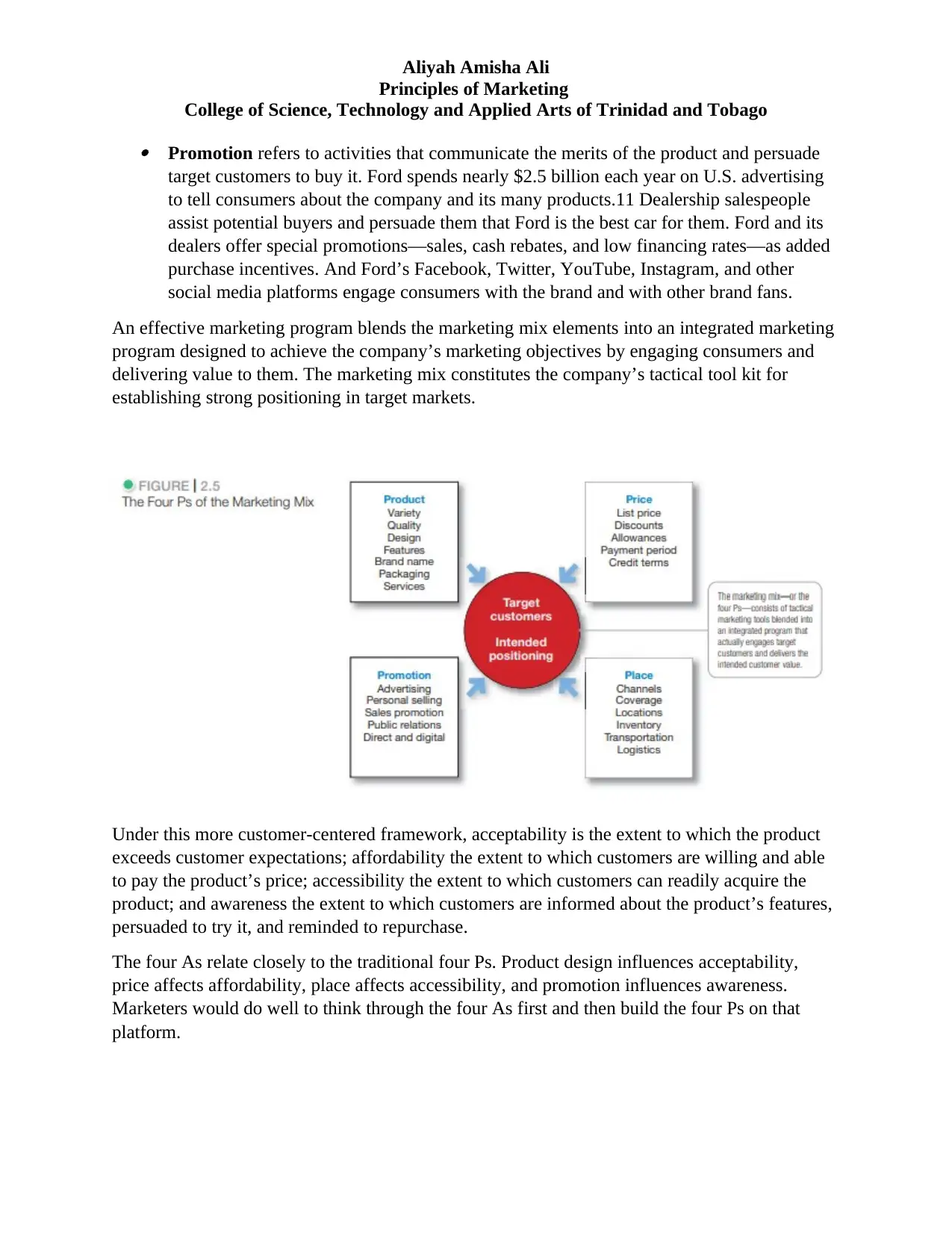
Aliyah Amisha Ali
Principles of Marketing
College of Science, Technology and Applied Arts of Trinidad and Tobago Promotion refers to activities that communicate the merits of the product and persuade
target customers to buy it. Ford spends nearly $2.5 billion each year on U.S. advertising
to tell consumers about the company and its many products.11 Dealership salespeople
assist potential buyers and persuade them that Ford is the best car for them. Ford and its
dealers offer special promotions—sales, cash rebates, and low financing rates—as added
purchase incentives. And Ford’s Facebook, Twitter, YouTube, Instagram, and other
social media platforms engage consumers with the brand and with other brand fans.
An effective marketing program blends the marketing mix elements into an integrated marketing
program designed to achieve the company’s marketing objectives by engaging consumers and
delivering value to them. The marketing mix constitutes the company’s tactical tool kit for
establishing strong positioning in target markets.
Under this more customer-centered framework, acceptability is the extent to which the product
exceeds customer expectations; affordability the extent to which customers are willing and able
to pay the product’s price; accessibility the extent to which customers can readily acquire the
product; and awareness the extent to which customers are informed about the product’s features,
persuaded to try it, and reminded to repurchase.
The four As relate closely to the traditional four Ps. Product design influences acceptability,
price affects affordability, place affects accessibility, and promotion influences awareness.
Marketers would do well to think through the four As first and then build the four Ps on that
platform.
Principles of Marketing
College of Science, Technology and Applied Arts of Trinidad and Tobago Promotion refers to activities that communicate the merits of the product and persuade
target customers to buy it. Ford spends nearly $2.5 billion each year on U.S. advertising
to tell consumers about the company and its many products.11 Dealership salespeople
assist potential buyers and persuade them that Ford is the best car for them. Ford and its
dealers offer special promotions—sales, cash rebates, and low financing rates—as added
purchase incentives. And Ford’s Facebook, Twitter, YouTube, Instagram, and other
social media platforms engage consumers with the brand and with other brand fans.
An effective marketing program blends the marketing mix elements into an integrated marketing
program designed to achieve the company’s marketing objectives by engaging consumers and
delivering value to them. The marketing mix constitutes the company’s tactical tool kit for
establishing strong positioning in target markets.
Under this more customer-centered framework, acceptability is the extent to which the product
exceeds customer expectations; affordability the extent to which customers are willing and able
to pay the product’s price; accessibility the extent to which customers can readily acquire the
product; and awareness the extent to which customers are informed about the product’s features,
persuaded to try it, and reminded to repurchase.
The four As relate closely to the traditional four Ps. Product design influences acceptability,
price affects affordability, place affects accessibility, and promotion influences awareness.
Marketers would do well to think through the four As first and then build the four Ps on that
platform.
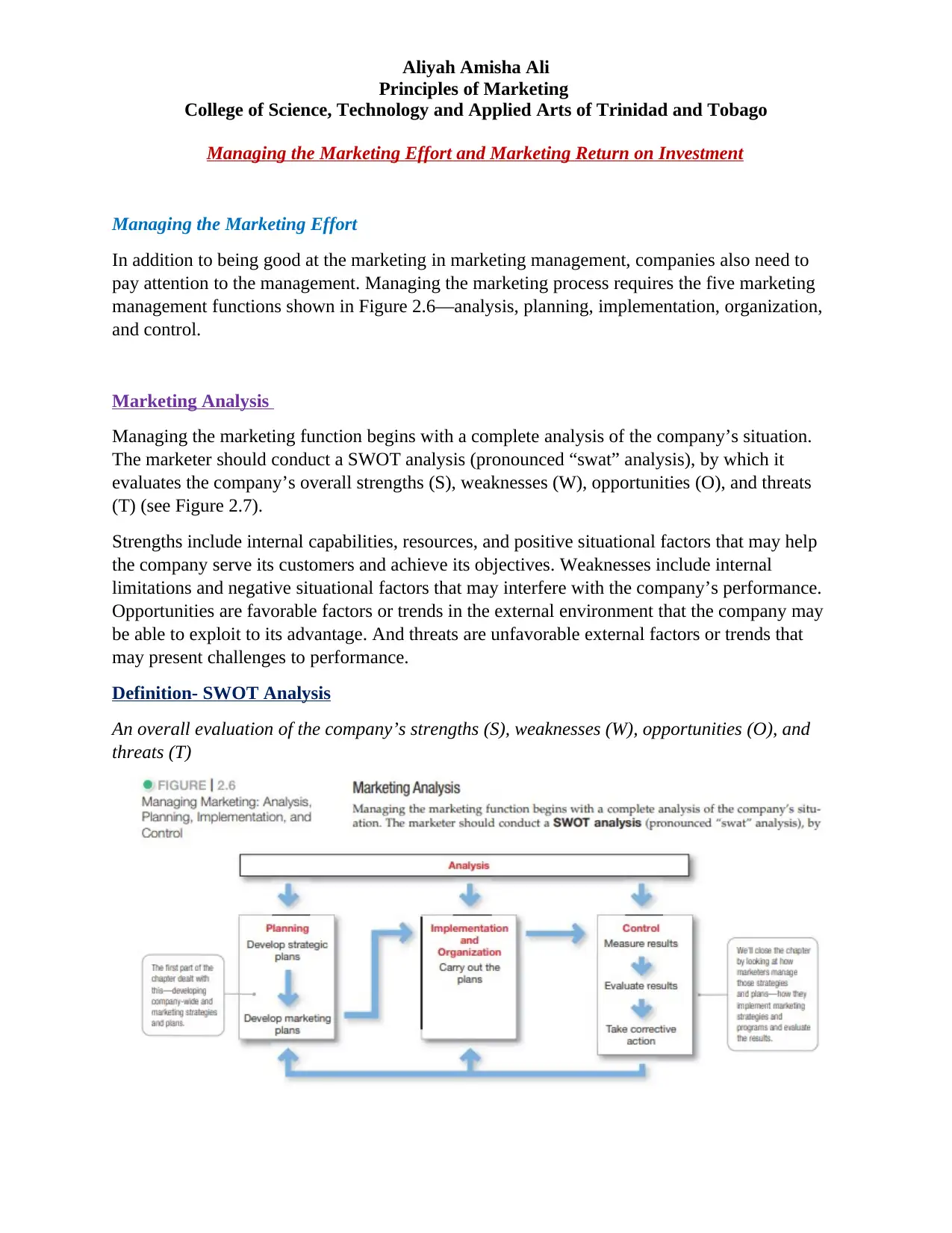
Aliyah Amisha Ali
Principles of Marketing
College of Science, Technology and Applied Arts of Trinidad and Tobago
Managing the Marketing Effort and Marketing Return on Investment
Managing the Marketing Effort
In addition to being good at the marketing in marketing management, companies also need to
pay attention to the management. Managing the marketing process requires the five marketing
management functions shown in Figure 2.6—analysis, planning, implementation, organization,
and control.
Marketing Analysis
Managing the marketing function begins with a complete analysis of the company’s situation.
The marketer should conduct a SWOT analysis (pronounced “swat” analysis), by which it
evaluates the company’s overall strengths (S), weaknesses (W), opportunities (O), and threats
(T) (see Figure 2.7).
Strengths include internal capabilities, resources, and positive situational factors that may help
the company serve its customers and achieve its objectives. Weaknesses include internal
limitations and negative situational factors that may interfere with the company’s performance.
Opportunities are favorable factors or trends in the external environment that the company may
be able to exploit to its advantage. And threats are unfavorable external factors or trends that
may present challenges to performance.
Definition- SWOT Analysis
An overall evaluation of the company’s strengths (S), weaknesses (W), opportunities (O), and
threats (T)
Principles of Marketing
College of Science, Technology and Applied Arts of Trinidad and Tobago
Managing the Marketing Effort and Marketing Return on Investment
Managing the Marketing Effort
In addition to being good at the marketing in marketing management, companies also need to
pay attention to the management. Managing the marketing process requires the five marketing
management functions shown in Figure 2.6—analysis, planning, implementation, organization,
and control.
Marketing Analysis
Managing the marketing function begins with a complete analysis of the company’s situation.
The marketer should conduct a SWOT analysis (pronounced “swat” analysis), by which it
evaluates the company’s overall strengths (S), weaknesses (W), opportunities (O), and threats
(T) (see Figure 2.7).
Strengths include internal capabilities, resources, and positive situational factors that may help
the company serve its customers and achieve its objectives. Weaknesses include internal
limitations and negative situational factors that may interfere with the company’s performance.
Opportunities are favorable factors or trends in the external environment that the company may
be able to exploit to its advantage. And threats are unfavorable external factors or trends that
may present challenges to performance.
Definition- SWOT Analysis
An overall evaluation of the company’s strengths (S), weaknesses (W), opportunities (O), and
threats (T)
⊘ This is a preview!⊘
Do you want full access?
Subscribe today to unlock all pages.

Trusted by 1+ million students worldwide
1 out of 16
Related Documents
Your All-in-One AI-Powered Toolkit for Academic Success.
+13062052269
info@desklib.com
Available 24*7 on WhatsApp / Email
![[object Object]](/_next/static/media/star-bottom.7253800d.svg)
Unlock your academic potential
Copyright © 2020–2025 A2Z Services. All Rights Reserved. Developed and managed by ZUCOL.





